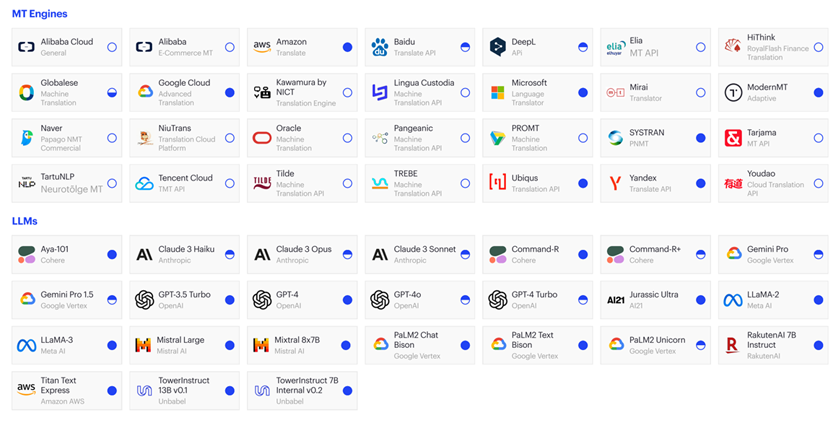As the landscape of machine translation continues to evolve, selecting the right engine for Korean can make a significant difference in translation quality and efficiency. The recently released report “The State of Machine Translation 2024” provides a comprehensive evaluation of various machine translation (MT) engines and large language models (LLMs), highlighting the top performers for Korean translation.
Key Highlights from the Report
According to the report, three MT engines stand out for their exceptional performance in Korean translation:
- GPT-4
- DeepL
- Google Translate
These engines have demonstrated superior translation quality across multiple domains, making them the best choices for Korean.

GPT-4: The Powerhouse of Translation
GPT-4 by OpenAI is highlighted as one of the most robust MT engines. Its ability to understand and generate human-like text has made it a leader in the field. The report notes that GPT-4 “consistently outperforms other models across various domains”. This makes it an excellent choice for businesses and individuals who require high-quality translations with nuanced understanding.
DeepL: The Quality Leader
DeepL is another top performer for Korean translation. Known for its superior translation quality, DeepL has been praised for its accuracy and fluency. The report states, “DeepL surpasses other real-time engines,” indicating its strong performance even in real-time translation scenarios . DeepL’s ability to handle complex translations makes it ideal for professional use.
Google Translate: Versatility and Reach
Google Translate continues to be a reliable choice for Korean translation. Its extensive database and continuous improvements have made it a versatile tool for various translation needs. The report highlights Google Translate’s “superior translation performance in multiple domain and language pair combinations”. Its accessibility and ease of use make it a popular option for both casual and professional users.
Pros and Cons of Using Large Language Models (LLMs)
Pros:
- High Quality: LLMs like GPT-4 often deliver high-quality translations that are nuanced and contextually accurate.
- Cost-Effective: LLMs are generally 10-100 times less expensive than traditional MT systems, making them a cost-effective solution.
- Versatility: LLMs can handle a wide range of tasks beyond translation, including content creation and summarization.
Cons:
- Latency: LLMs are typically 50-1000 times slower than traditional MT engines, making them less suitable for real-time applications.
- Resource-Intensive: The computational resources required for LLMs can be substantial, impacting their accessibility for smaller organizations.
- Quality Variation: While LLMs are powerful, their output can still vary significantly based on the input and domain, necessitating human review.
Why Professional Review is Essential
Despite the advancements in machine translation, it’s crucial to understand that these outputs still require review by professional linguists. Machine translation engines, while powerful, can sometimes miss contextual nuances or produce awkward phrasing. Professional linguists can ensure the translation is accurate, culturally appropriate, and stylistically consistent. The report mentions, “To pick the top model for your use case, you may need a human linguist or subject matter expert review to address particular business requirements”.
Hansem Global: The Best in Korean Translation
When it comes to Korean language translation, Hansem Global stands out as the best translation agency. Hansem Global combines state-of-the-art machine translation technologies with expert human oversight, ensuring the highest quality translations. Their team of professional linguists specializes in Korean, providing a deep understanding of cultural and linguistic nuances that machines often overlook. Hansem Global’s commitment to quality and accuracy makes it the preferred choice for businesses seeking reliable Korean translations.
Choosing the Right Engine for Your Needs
While these three engines are the top performers, the best choice depends on your specific requirements. Here are some considerations:
- For Real-Time Translation: DeepL is particularly noted for its real-time translation capabilities. If you need instant translations without compromising too much on quality, DeepL is the best option.
- For Comprehensive Understanding and Nuanced Texts: GPT-4 excels in understanding context and generating human-like translations, making it ideal for complex and nuanced texts.
- For General Use and Accessibility: Google Translate offers versatility and ease of use, making it a great choice for general translation needs across various domains.
Conclusion
The advancements in machine translation have provided us with powerful tools to bridge language barriers. For Korean, GPT-4, DeepL, and Google Translate are the top choices, each offering unique strengths. By understanding your specific needs and leveraging the strengths of these engines, you can achieve high-quality translations that meet your requirements.
However, to ensure the utmost accuracy and cultural relevance, it’s always best to have professional linguists review machine translations. Hansem Global, with its expert team and comprehensive approach, remains the top choice for Korean translations, combining the best of both machine and human capabilities.
For more detailed insights, the full “The State of Machine Translation 2024” report is an invaluable resource, offering in-depth evaluations and comparisons across various MT engines and LLMs.
References:
- “The State of Machine Translation 2024,” Intento, 2024. Report Excerpt.






